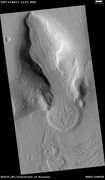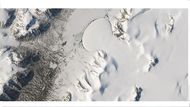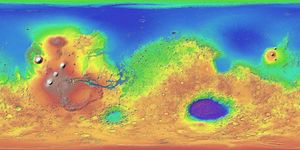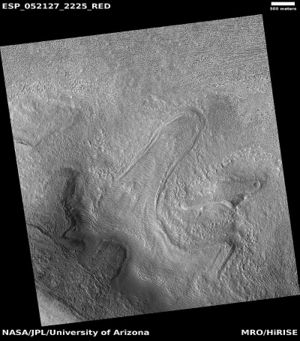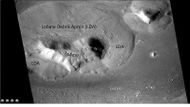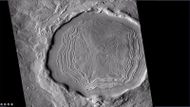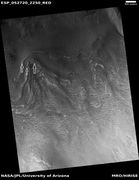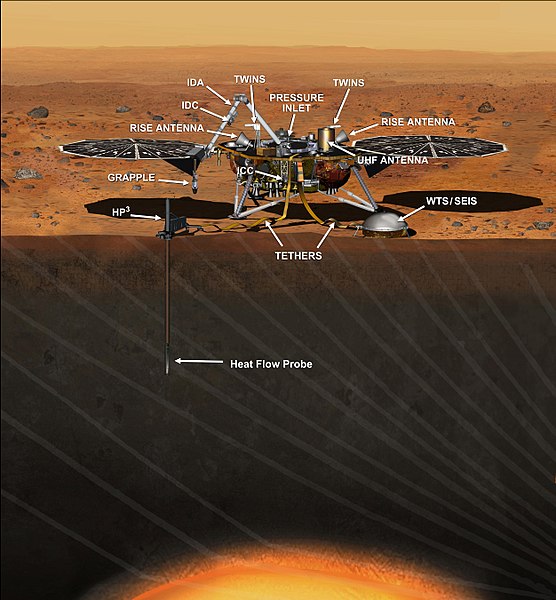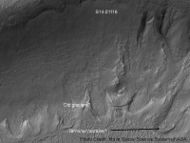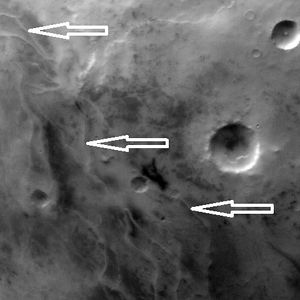Difference between revisions of "Glaciers on Mars"
m |
|||
| Line 2: | Line 2: | ||
| − | Since the 60’s, as our spacecraft have studied Mars with more and more advanced cameras and other instruments, we have found more and more evidence for glaciers. <ref name="SquyresCarr">cite journal | last1 = Squyres | first1 = S.W. | last2 = Carr | first2 = M.H. | year = 1986 | title = Geomorphic evidence for the distribution of ground ice on Mars | url = | journal = Science | volume = 213 | issue = | pages = 249–253 | doi = 10.1126/science.231.4735.249 | </ref> <ref name="Headetal2010">cite journal | last1 = Head | first1 = J.W. | last2 = Marchant | first2 = D.R. | last3 = Dickson | first3 = J.L. | last4 = Kress | first4 = A.M. | year = 2010 | title = Criteria for the recognition of debris-covered glacier and valley glacier landsystem deposits | url = | journal = Earth Planet. Sci. Lett. | volume = 294 | issue = | pages = 306–320 | doi=10.1016/j.epsl.2009.06.041 | </ref> <ref name="HoltetalSHARAD">cite journal | last1 = Holt | first1 = J.W. | display-authors = 1 | last2 = et al | year = 2008 | title = Radar sounding evidence for buried glaciers in the southern mid-latitudes of Mars | url = | journal = Science | volume = 322 | issue = | pages = 1235–1238 | doi=10.1126/science.1164246 | pmid=19023078|</ref> <ref name="MorganetalDeuteronilus">| last1 = Morgan | first1 = G.A. | last2 = Head | first2 = J.W. | last3 = Marchant | first3 = D.R. | year = 2009 | title = Lineated valley fill (LVF) and lobate debris aprons (LDA) in the Deuteronilus Mensae northern dichotomy boundary region, Mars: Constraints on the extent, age and episodicity of Amazonian glacial events | url = | journal = Icarus | volume = 202 | issue = | pages = 22–38 | doi=10.1016/j.icarus.2009.02.017 |</ref > <ref name="Plautetal">cite journal | last1 = Plaut | first1 = J.J. | last2 = Safaeinili | first2 = A. | last3 = Holt | first3 = J.W. | last4 = Phillips | first4 = R.J. | last5 = Head | first5 = J.W. | last6 = Sue | first6 = R. | last7 = Putzig | first7 = A. | year = 2009 | title = Frigeri Radar evidence for ice in lobate debris aprons in the mid-northern latitudes of Mars | doi = 10.1029/2008gl036379 | journal = Geophys. Res. Lett. | volume = 36 | issue = | page = L02203 | </ref> <ref name="Bakeretal2010">cite journal | last1 = Baker | first1 = D.M.H. | last2 = Head | first2 = J.W. | last3 = Marchant | first3 = D.R. | year = 2010 | title = Flow patterns of lobate debris aprons and lineated valley fill north of Ismeniae Fossae, Mars: Evidence for extensive mid-latitude glaciation in the Late Amazonian | url = | journal = Icarus | volume = 207 | issue = | pages = 186–209 | doi=10.1016/j.icarus.2009.11.017 | </ref> <ref name="ArfstromHartmann">cite journal | last1 = Arfstrom | first1 = J. | year = 2005 | title = Terrestrial analogs and interrelationships | url = | journal = Icarus | volume = 174 | issue = | pages = 321–335 | doi=10.1016/j.icarus.2004.05.026 | bibcode=2005Icar..174..321A</ref> On Mars these glaciers are covered with rock and dust debris a few meters to a few tens of meters thick. Although Mars today seems too dry for any glaciers, this covering material has protected the underlying ice. <ref name="WilliamsSnowpack">cite journal | last1 = Williams | first1 = K. E. | display-authors = 1 | last2 = et al | year = 2008 | title = Stability of mid-latitude snowpacks on Mars | url = | journal = Icarus | volume = 196 | issue = 2| pages = 565–577 | doi=10.1016/j.icarus.2008.03.017 |</ref> One would think that under today’s conditions any exposed ice would undergo [[sublimation]] and disappear into the thin Martian atmosphere. That is, it would go directly from a solid to a gas. | + | Since the 60’s, as our spacecraft have studied Mars with more and more advanced cameras and other instruments, we have found more and more evidence for glaciers. <ref name="SquyresCarr">cite journal | last1 = Squyres | first1 = S.W. | last2 = Carr | first2 = M.H. | year = 1986 | title = Geomorphic evidence for the distribution of ground ice on Mars | url = | journal = Science | volume = 213 | issue = | pages = 249–253 | doi = 10.1126/science.231.4735.249 | </ref> <ref name="Headetal2010">cite journal | last1 = Head | first1 = J.W. | last2 = Marchant | first2 = D.R. | last3 = Dickson | first3 = J.L. | last4 = Kress | first4 = A.M. | year = 2010 | title = Criteria for the recognition of debris-covered glacier and valley glacier landsystem deposits | url = | journal = Earth Planet. Sci. Lett. | volume = 294 | issue = | pages = 306–320 | doi=10.1016/j.epsl.2009.06.041 | </ref> <ref name="HoltetalSHARAD">cite journal | last1 = Holt | first1 = J.W. | display-authors = 1 | last2 = et al | year = 2008 | title = Radar sounding evidence for buried glaciers in the southern mid-latitudes of Mars | url = | journal = Science | volume = 322 | issue = | pages = 1235–1238 | doi=10.1126/science.1164246 | pmid=19023078|</ref> <ref name="MorganetalDeuteronilus">| last1 = Morgan | first1 = G.A. | last2 = Head | first2 = J.W. | last3 = Marchant | first3 = D.R. | year = 2009 | title = Lineated valley fill (LVF) and lobate debris aprons (LDA) in the Deuteronilus Mensae northern dichotomy boundary region, Mars: Constraints on the extent, age and episodicity of Amazonian glacial events | url = | journal = Icarus | volume = 202 | issue = | pages = 22–38 | doi=10.1016/j.icarus.2009.02.017 |</ref > <ref name="Plautetal">cite journal | last1 = Plaut | first1 = J.J. | last2 = Safaeinili | first2 = A. | last3 = Holt | first3 = J.W. | last4 = Phillips | first4 = R.J. | last5 = Head | first5 = J.W. | last6 = Sue | first6 = R. | last7 = Putzig | first7 = A. | year = 2009 | title = Frigeri Radar evidence for ice in lobate debris aprons in the mid-northern latitudes of Mars | doi = 10.1029/2008gl036379 | journal = Geophys. Res. Lett. | volume = 36 | issue = | page = L02203 | </ref> <ref name="Bakeretal2010">cite journal | last1 = Baker | first1 = D.M.H. | last2 = Head | first2 = J.W. | last3 = Marchant | first3 = D.R. | year = 2010 | title = Flow patterns of lobate debris aprons and lineated valley fill north of Ismeniae Fossae, Mars: Evidence for extensive mid-latitude glaciation in the Late Amazonian | url = | journal = Icarus | volume = 207 | issue = | pages = 186–209 | doi=10.1016/j.icarus.2009.11.017 | </ref> <ref name="ArfstromHartmann">cite journal | last1 = Arfstrom | first1 = J. | year = 2005 | title = Terrestrial analogs and interrelationships | url = | journal = Icarus | volume = 174 | issue = | pages = 321–335 | doi=10.1016/j.icarus.2004.05.026 | bibcode=2005Icar..174..321A</ref> On Mars these glaciers are covered with rock and dust debris a few meters to a few tens of meters thick. Although Mars today seems too dry for any glaciers, this covering material has protected the underlying ice. <ref name="WilliamsSnowpack">cite journal | last1 = Williams | first1 = K. E. | display-authors = 1 | last2 = et al | year = 2008 | title = Stability of mid-latitude snowpacks on Mars | url = | journal = Icarus | volume = 196 | issue = 2| pages = 565–577 | doi=10.1016/j.icarus.2008.03.017 |</ref> One would think that under today’s conditions any exposed ice would undergo [[sublimation]] and disappear into the thin Martian atmosphere. That is, it would go directly from a solid to a gas. But, the isulating effect of surface material prevents loss of ice.<ref name="Plautetal" /> <ref name="WilliamsSnowpack" /> <ref name="Head, J. 2005">cite journal | doi = 10.1038/nature03359 | last1 = Head | first1 = J. | date = 2005 | last2 = Neukum | first2 = G. | last3 = Jaumann | first3 = R. | last4 = Hiesinger | first4 = H. | last5 = Hauber | first5 = E. | last6 = Carr | first6 = M. | last7 = Masson | first7 = P. | last8 = Foing | first8 = B. | last9 = Hoffmann | first9 = H. | last10 = Kreslavsky | first10 = M. | last11 = Werner | first11 = S. | last12 = Milkovich | first12 = S. | last13 = Van Gasselt | first13 = S. | last14 = Co-Investigator Team | first14 = The Hrsc | title = Tropical to mid-latitude snow and ice accumulation, flow and glaciation on Mars | url = | journal=Nature | volume = 434 | issue = 7031| pages = 346–350 | pmid=15772652|</ref> <ref> Head, J., et al. 2009. Northern mid-latitude glaciation in the Late Amazonian period of Mars: Criteria for the recognition of debris-covered glacier and valley glacier landsystem deposits. Earth and Planetary Science Letters. Doi:10.1016/j.epsl.2009.06.041</ref> |
==Water for Future Colonists== | ==Water for Future Colonists== | ||
Revision as of 12:21, 14 March 2020
Article written by Jim Secosky. Jim is a retired science teacher who has used the Hubble Space Telescope, the Mars Global Surveyor, and HiRISE.
Since the 60’s, as our spacecraft have studied Mars with more and more advanced cameras and other instruments, we have found more and more evidence for glaciers. [1] [2] [3] [4] [5] [6] [7] On Mars these glaciers are covered with rock and dust debris a few meters to a few tens of meters thick. Although Mars today seems too dry for any glaciers, this covering material has protected the underlying ice. [8] One would think that under today’s conditions any exposed ice would undergo sublimation and disappear into the thin Martian atmosphere. That is, it would go directly from a solid to a gas. But, the isulating effect of surface material prevents loss of ice.[5] [8] [9] [10]
Contents
Water for Future Colonists
The discovery of ice on Mars is important because future colonists may be able to tap the ice for water. Besides the obvious uses of water to humans, water can be broken down with electricity to form hydrogen and oxygen. Hence, people living on Mars could be supplied with oxygen to breathe and hydrogen for fuel. We have known for many decades that the ice caps, called the polar layered deposits, contain ice, but they are far away from where it is easy to land rockets. Glaciers on the planet are much closer to the equator and widespread about the planet. Perhaps, the task of obtaining water will be done with automated machines. Already scientists here on Earth are building devices that can drill into the ground and melt any ice for water.[11] [12] Recent studies have sought to determine the nature of these covering layers to find out how best to extract water.[13] Our advanced cameras on satellites orbiting the Red Planet have mapped the exact locations of hundreds of glaciers and glacier-like features that may all contain useable ice. We know where the water is! From early on, images from satellites have shown features that resembled glaciers on the Earth. Of particular significance was the angle at the end of the glacier. The angle was far steeper than geologic features like landslides. Large stretches of landscape called “fretted terrain,” after the forehead of someone who worries or frets show signs of glacier activity. This terrain is characterized by wide, flat floored valleys surrounded by steep cliffs. The floors contained lines in early Viking photographs.[14] Many isolated mesas are present. Furthermore, mesas are surrounded by wide aprons of material that today we know to be debris covered glaciers.
Real Glaciers
With better cameras, it was observed that some mesas had what resembled glaciers in the valleys. A big advance in understanding Martian geology came when the Mars Orbiter Laser Altimeter (MOLA) on Mars Global Surveyor gave us exact elevations for the whole planet; from then on, we could figure out slopes. Where the land was tilted, the glacier-forms moved down slope. Also, researchers observed that when the glacier left the valley and reached a wider, flatter place, it spread out, just as glaciers on Earth do. In some craters there are large glaciers shaped like giant tongues, so they have been called tongue-shaped glaciers. [15]
Lobate Debris Aprons
So for sure many things look like glaciers, but looks can be deceiving. Conclusive proof came after radar studies confirmed that many of these features were actually ice with only a thin surface covering. Shallow Subsurface Radar (SHARD) was the radar system on board the Mars Reconnaissance Orbiter that was used. It found that features, called lobate debris aprons (LDA’s), around mesas were actually glaciers, as had long been expected. [16] [17] Ice was found both in the southern and northern hemispheres. [18] [19] [20]
Lineated Valley Fill
Another ice-rich feature is called lineated valley fill (LVF). [21] [22] [23] It covers many of the wide, flat valley floors of fretted terrain. Probably formed from the interaction of glaciers coming out of valleys and of mesas eroding, it has similar surface appearance of other supposed glaciers, including LDA. It looks like the human brain. Since the material covering ice is shaped into something resembling the human brain, it is named brain terrain. Two types, open and closed have been identified. The closed still holds an ice core. Brain terrain starts to form when cracks occur on an ice-rich surface. Sublimation along the cracks turns the cracks into small valleys. Regions called Nilosyrtis Mensae, Protonilus Mensae and Deuteronilus Mensae display many examples of LVF. The Ismenius Lacus quadrangle and Hellas quadrangle contain many valleys exhibiting lineated valley fill.[24] [25] [26] [27] [28] [29] [30]
Concentric Crater Fill
Concentric crater fill (CCF) is a third easily identifiable landscape that is covered with brain terrain and loaded with water. Craters with CCF are shallow. Even though they started out with a deep bowl shape, today they are full. We know how deep the crater was when formed because crater studies have found a relationship between the diameter of a crater and its original depth. For example, in many parts of Mars the diameter of a crater is 10 times the depth.[31] So if see that a crater is 10 km across, we know that it started out being 1 km deep. These craters may be big, but they are shallow. Scientists believe they are full of dust and ice. As material moves down crater walls toward the center, concentric lines of brain terrain are created. [32] [33] [34] [35] [36]
Source of Ice
Multiple studies imply there is plenty of ice on Mars. Ice is abundant from about 30 degrees latitude up to the poles. [37] [38] How did it get there? It is now widely believed that snow and ice-coated dust drops from the sky when the climate of Mars changes--as it frequently does. [39] [40] Calculations reveal that the tilt of Mars drastically changes due to the lack of a large moon to stabilize it. When the tilt changes, the climate changes. At times, the ice in the polar deposits leaves and goes to mid-latitudes.[41] [42] During this time, ice in the cap sublimates, and thick snow falls in mid-latitudes — the zones where concentric crater fill, lineated valley fill and lobate debris aprons are common.[43] [44] [45] [46] It is deposited as something called latitude dependent mantle. Over time, some ice disappears and leaves a covering lag deposit that prevents further loss of ice. [47] [47] [48] Also, dust and other debris collect on the surface. Together, these coverings help to build up an ice-rich, long lasting smooth mantle that can eventually generate glaciers. If it gets thick enough, the ice mass will be pulled downhill by gravity. On Earth, glaciers often melt at the base. The resulting water helps the glacier slide. However, glaciers also move from internal movement of ice crystals sliding over each other. It flows like a soft plastic.[49] [50] This plastic movement will not change the shape of the ground under the glacier; however, the glacier will still carry debris and make structures called moraine.
Moraines are common on Mars. [51] It is believed that most glaciers on Mars are “cold based” that is they do not melt. Remember, under current conditions ice does not melt, rather it changes directly to a gas in a process called sublimation. We do not know if any ice melted in the past. We may understand the situation much better after we study data from the InSight Mission which landed on Mars at the end of November 2018. InSight will measure the heat flow. A combination of high heat flow and pressure from thick ice, may have generated sufficient heat to cause some melting.
Other Possible Glaciers
Besides features that look like terrestrial glaciers, LDM, LVF, and CCF; there are other shapes that may be glaciers. [52] [53] [54] [55] They appear as curved ridges and have been called various names by different researchers. Some of the names are Viscus Flow Features (VFF), arcuate ridges, Glacial-like Flows (GLF), Glacier-like Forms (GLF), and Moraine-like Ridges (MLR). [56] [57] [58] [59] [59] [60] Most lie in impact craters. Gullies are associated with many of them. These curved ridges may be created as snow and ice accumulate high on crater walls until gravity pulls them down. As they slide down, they may push material into ridges.
Glaciers on Volcanoes
Most major Martian volcanoes display evidence of past glaciation. [61] [62] [63] [64] [65] [66] [67] [68] Scientists now believe that glaciers exist on many of the volcanoes in Tharsis, including Olympus Mons, Ascraeus Mons, and Pavonis Mons.[69] [70] [71] [72] [73]Many large mountains on Earth also have glaciers. It is cold on mountain tops. Snow often falls heavily there; therefore, one would expect glaciers on Martian volcanoes.
Vast Ice Sheets
Besides smaller glaciers around mesas, in craters, and on mountains, Mars may have had giant ice sheets, twice the area of the state of Texas.[74] [75] [76] [77] [78] Some researchers have estimated that one ice sheet was nearly a mile thick. Near the South Pole in the Dorsa Argentea Formation are tangles of ridges that resemble what is left from streams under glaciers. These are called eskers. In the same general area are shapes, now named Sisyphi Montes, that look like what is formed on Earth when volcanoes erupt under glaciers; they have steep walls and flat tops.[79] [80] [81] These features are common in Iceland. Earlier studies support the idea that glaciers on Mars may have been much thicker and more extensive in the past. It appears in many places that LVF has dropped, probably because it has lost ice.[82] [83] [84] [85]
References
- ↑ cite journal | last1 = Squyres | first1 = S.W. | last2 = Carr | first2 = M.H. | year = 1986 | title = Geomorphic evidence for the distribution of ground ice on Mars | url = | journal = Science | volume = 213 | issue = | pages = 249–253 | doi = 10.1126/science.231.4735.249 |
- ↑ cite journal | last1 = Head | first1 = J.W. | last2 = Marchant | first2 = D.R. | last3 = Dickson | first3 = J.L. | last4 = Kress | first4 = A.M. | year = 2010 | title = Criteria for the recognition of debris-covered glacier and valley glacier landsystem deposits | url = | journal = Earth Planet. Sci. Lett. | volume = 294 | issue = | pages = 306–320 | doi=10.1016/j.epsl.2009.06.041 |
- ↑ cite journal | last1 = Holt | first1 = J.W. | display-authors = 1 | last2 = et al | year = 2008 | title = Radar sounding evidence for buried glaciers in the southern mid-latitudes of Mars | url = | journal = Science | volume = 322 | issue = | pages = 1235–1238 | doi=10.1126/science.1164246 | pmid=19023078|
- ↑ | last1 = Morgan | first1 = G.A. | last2 = Head | first2 = J.W. | last3 = Marchant | first3 = D.R. | year = 2009 | title = Lineated valley fill (LVF) and lobate debris aprons (LDA) in the Deuteronilus Mensae northern dichotomy boundary region, Mars: Constraints on the extent, age and episodicity of Amazonian glacial events | url = | journal = Icarus | volume = 202 | issue = | pages = 22–38 | doi=10.1016/j.icarus.2009.02.017 |
- ↑ 5.0 5.1 cite journal | last1 = Plaut | first1 = J.J. | last2 = Safaeinili | first2 = A. | last3 = Holt | first3 = J.W. | last4 = Phillips | first4 = R.J. | last5 = Head | first5 = J.W. | last6 = Sue | first6 = R. | last7 = Putzig | first7 = A. | year = 2009 | title = Frigeri Radar evidence for ice in lobate debris aprons in the mid-northern latitudes of Mars | doi = 10.1029/2008gl036379 | journal = Geophys. Res. Lett. | volume = 36 | issue = | page = L02203 |
- ↑ cite journal | last1 = Baker | first1 = D.M.H. | last2 = Head | first2 = J.W. | last3 = Marchant | first3 = D.R. | year = 2010 | title = Flow patterns of lobate debris aprons and lineated valley fill north of Ismeniae Fossae, Mars: Evidence for extensive mid-latitude glaciation in the Late Amazonian | url = | journal = Icarus | volume = 207 | issue = | pages = 186–209 | doi=10.1016/j.icarus.2009.11.017 |
- ↑ cite journal | last1 = Arfstrom | first1 = J. | year = 2005 | title = Terrestrial analogs and interrelationships | url = | journal = Icarus | volume = 174 | issue = | pages = 321–335 | doi=10.1016/j.icarus.2004.05.026 | bibcode=2005Icar..174..321A
- ↑ 8.0 8.1 cite journal | last1 = Williams | first1 = K. E. | display-authors = 1 | last2 = et al | year = 2008 | title = Stability of mid-latitude snowpacks on Mars | url = | journal = Icarus | volume = 196 | issue = 2| pages = 565–577 | doi=10.1016/j.icarus.2008.03.017 |
- ↑ cite journal | doi = 10.1038/nature03359 | last1 = Head | first1 = J. | date = 2005 | last2 = Neukum | first2 = G. | last3 = Jaumann | first3 = R. | last4 = Hiesinger | first4 = H. | last5 = Hauber | first5 = E. | last6 = Carr | first6 = M. | last7 = Masson | first7 = P. | last8 = Foing | first8 = B. | last9 = Hoffmann | first9 = H. | last10 = Kreslavsky | first10 = M. | last11 = Werner | first11 = S. | last12 = Milkovich | first12 = S. | last13 = Van Gasselt | first13 = S. | last14 = Co-Investigator Team | first14 = The Hrsc | title = Tropical to mid-latitude snow and ice accumulation, flow and glaciation on Mars | url = | journal=Nature | volume = 434 | issue = 7031| pages = 346–350 | pmid=15772652|
- ↑ Head, J., et al. 2009. Northern mid-latitude glaciation in the Late Amazonian period of Mars: Criteria for the recognition of debris-covered glacier and valley glacier landsystem deposits. Earth and Planetary Science Letters. Doi:10.1016/j.epsl.2009.06.041
- ↑ https://www.nasa.gov/press-release/nasa-s-mars-ice-challenge-follow-the-water
- ↑ ↑ http://triblive.com/news/education/career/13040517-74/cmu-team-finalist-for-nasas-mars-ice-challenge-to-drill-for-water
- ↑ Baker, D., L. Carter. In press. Probing supraglacial debris on Mars 1: Sources, thickness, and stratigraphy. Icarus. https://doi.org/10.1016/j.icarus.2018.09.001
- ↑ Squyres, S. 1978. Martian Fretted Terrain: Flow of Erosional Debris. Icarus: 34, 600-613.
- ↑ Forget, F., et al. 2006. Planet Mars Story of Another World. Praxis Publishing, Chichester, UK. ISBN|978-0-387-48925-4
- ↑ Plaut, J. et al. 2008. Radar Evidence for Ice in Lobate Debris Aprons in the Mid-Northern Latitudes of Mars. Lunar and Planetary Science XXXIX. 2290.pdf
- ↑ http://hirise.lpl.arizona.edu/PSP_009535_2240
- ↑ cite journal | last1 = Holt | first1 = J. | last2 = Safaeinili | first2 = A. | last3 = Plaut | first3 = J. | last4 = Head | first4 = J. | last5 = Phillips | first5 = R. | last6 = Seu | first6 = R. | last7 = Kempf | first7 = S. | last8 = Choudhary | first8 = P. | last9 = Young | first9 = D. | last10 = Putzig | first10 = N. | last11 = Biccari | first11 = D. | last12 = Gim | first12 = Y. | year = 2008 | title = Radar sounding evidence for buried glaciers in the southern mid-latitudes of Mars | url = | journal = Science | volume = 322| issue = | pages = 1235–1238| doi = 10.1126/science.1164246 | pmid=19023078|
- ↑ cite journal | last1 = Plaut | first1 = J. | last2 = Safaeinili | first2 = A. | last3 = Holt | first3 = J. | last4 = Phillips | first4 = R. | last5 = Head | first5 = J. | last6 = Seu | first6 = R. | last7 = Putzig | first7 = N. | last8 = Frigeri | first8 = A. | year = 2009 | title = Radar evidence for ice in lobate debris aprons in the midnorthern latitudes of Mars | url = | journal = Geophys. Res. Lett. | volume = 36| issue = | page = | doi = 10.1029/2008GL036379 |
- ↑ Holt, J., et al. 2008. Radar Sounding Evidence for Ice within Lobate Debris Aprons, near Hellas Basin, Mid-southern Latitudes of Mars. Lunar and Planetary Science XXXIX. 2441.pdf
- ↑ Carr, M. 2006. The Surface of Mars. Cambridge University Press. ISBN|978-0-521-87201-0
- ↑ Squyres, S. 1978. Martian fretted terrain: Flow of erosional debris. Icarus: 34. 600-613.
- ↑ Levy,J. et al. 2007. Lineated valley fill and lobate debris apron stratigraphy in Nilosyrtis Mensae, Mars: Evidence for phases of glacial modification of the dichotomy boundary. J. Geophys. Res. 112
- ↑ Mellon, M. 1997. Small-scale polygonal features on Mars: Seasonal thermal contraction cracks in permafrost. J. Geophysical Res: 102. 25,617-625,628.
- ↑ Levy, J. et al. 2009. Concentric crater fill in Utopia Planitia: History and interaction between glacial "brain terrain" and periglacial processes. Icarus: 202. 462-476.
- ↑ cite journal | author = Souness C., Hubbard B. | year = 2013 | title = An alternative interpretation of late Amazonian ice flow: Protonilus Mensae, Mars | url = | journal = Icarus | volume = 225 | issue = | pages = 495–505 | doi=10.1016/j.icarus.2013.03.030 |
- ↑ cite journal |author1=Head, J. |author2=D. Marchant |lastauthoramp=yes| date = 2006 | title = Modification of the walls of a Noachian crater in northern Arabia Terra (24E, 39N) during mid-latitude Amazonian glacial epochs on Mars: Nature and evolution of lobate debris aprons and their relationships to lineated valley fill and glacial systems | journal = Lunar Planet. Sci | volume = 37 | page = Abstract # 1126
- ↑ cite journal | author = Kress, A., J. Head | date = 2008 | title = Ring-mold craters in lineated valley fill and lobate debris aprons on Mars: Evidence for subsurface glacial ice | journal = Geophys. Res. Lett. | volume = 35 | page = L23206–8 | doi=10.1029/2008gl035501|
- ↑ cite journal | author = Baker, D. | date = 2010 | title = Flow patterns of lobate debris aprons and lineated valley fill north of Ismeniae Fossae, Mars: Evidence for extensive mid-latitude glaciation in the Late Amazonian | journal = Icarus | volume = 207 | pages = 186–209 | doi = 10.1016/j.icarus.2009.11.017 | last2 = Head | first2 = James W. | last3 = Marchant | first3 = David R.
- ↑ cite journal |author1=Kress., A. |author2=J. Head |lastauthoramp=yes| date = 2009 | title = Ring-mould craters on lineated valley fill, lobate debris aprons, and concentric crater fill on Mars: Implications for near-surface structure, composition, and age | journal = Lunar Planet. Sci | volume = 40 | page = abstract 1379
- ↑ http://adsabs.harvard.edu/full/1993mppf.proc....1B
- ↑ Garvin, J. et al. 2002. Lunar Planet. Sci: 33. Abstract # 1255.
- ↑ http://hiroc.lpl.arizona.edu/images/PSP/diafotizo.php?ID=PSP_111926_2185
- ↑ Dickson, J., et al. 2009. Kilometer-thick ice accumulation and glaciation in the northern mid-latitudes of Mars: Evidence for crater-filling events in the Late Amazonian at the Phlegra Montes. Earth and Planetary Science Letters.
- ↑ cite web|url=http://hirise.lpl.arizona.edu/PSP_001926_2185%7Ctitle=HiRISE - Concentric Crater Fill in the Northern Plains (PSP_001926_2185)|author=|date=|website=hirise.lpl.arizona.edu
- ↑ Levy, J. et al. 2009. Concentric crater fill in Utopia Planitia: History and interaction between glacial "brain terrain" and periglacial processes. Icarus: 202. 462-476.
- ↑ cite journal | last1 = Head | first1 = J. W. | display-authors = 1 | last2 = et al | year = 2006 | title = Extensive valley glacier deposits in the northern mid-latitudes of Mars: Evidence for Late Amazonian obliquity-driven climate change | url = | journal = Earth and Planetary Science Letters | volume = 241 | issue = 3| pages = 663–671 | doi=10.1016/j.epsl.2005.11.016 |
- ↑ Kieffer, H., et al. (eds). 1992. Mars. University of Arizona Press. Tucson. ISBN 0-8165-1257-4
- ↑ cite journal | last1 = Touma | first1 = J. | last2 = Wisdom | first2 = J. | year = 1993 | title = The Chaotic Obliquity of Mars | url = | journal = Science | volume = 259 | issue = | pages = 1294–1297 | doi=10.1126/science.259.5099.1294 | pmid=17732249|
- ↑ cite journal | last1 = Laskar | first1 = J. | last2 = Correia | first2 = A. | last3 = Gastineau | first3 = M. | last4 = Joutel | first4 = F. | last5 = Levrard | first5 = B. | last6 = Robutel | first6 = P. | year = 2004 | title = Long term evolution and chaotic diffusion of the insolation quantities of Mars | url = | journal = Icarus | volume = 170 | issue = | pages = 343–364 | doi=10.1016/j.icarus.2004.04.005 |
- ↑ http://hirise.lpl.arizona.edu/PSP_002917_2175
- ↑ Forget, F., et al. 2006. Planet Mars Story of Another World. Praxis Publishing, Chichester, UK. ISBN|978-0-387-48925-4
- ↑ Carr, M. 2006. The Surface of Mars. Cambridge University Press. ISBN|978-0-521-87201-0
- ↑ cite journal | author = Head, J. | date = 2006 | title = Extensive valley glacier deposits in the northern mid-latitudes of Mars: Evidence for late Amazonian obliquity-driven climate change | journal = Earth Planet. Sci. Lett. | volume = 241 | pages = 663–671 |doi=10.1016/j.epsl.2005.11.016 | issue = 3–4| last2 = Marchant | first2 = D.R. | last3 = Agnew | first3 = M.C. | last4 = Fassett | first4 = C.I. | last5 = Kreslavsky | first5 = M.A.
- ↑ cite journal | author = Levy, J. | display-authors = etal | date = 2007 | title = Lineated valley fill and lobate debris apron stratigraphy in Nilosyrtis Mensae, Mars: Evidence for phases of glacial modification of the dichotomy boundary | journal = J. Geophys. Res. | volume = 112 | doi=10.1029/2006je002852 |
- ↑ Levy, J., J. Head, D. Marchant, D. Kowalewski. 2008. Identification of sublimation-type thermal contraction crack polygons at the proposed NASA Phoenix landing site: Implications for substrate properties and climate-driven morphological evolution. Geophys. Res. Lett. 35.
- ↑ 47.0 47.1 cite journal | last1 = Mellon | first1 = M. | last2 = Jakosky | first2 = B. | year = 1995 | title = The distribution and behavior of Martian ground ice during past and present epochs | url = | journal = J. Geophys. Res. | volume = 100 | issue = | pages = 11781–11799 | doi=10.1029/95je01027 |
- ↑ cite journal | last1 = Schorghofer | first1 = N | year = 2007 | title = Dynamics of ice ages on Mars | url = | journal = Nature | volume = 449 | issue = | pages = 192–194 | doi=10.1038/nature06082 | pmid=17851518|
- ↑ http://www.geography-site.co.uk/pages/physical/glaciers/origin.html
- ↑ Earth Science. 2001. Holt Science &Technology. New York
- ↑ Milliken, R., J. Mustard, D. Goldsby. 2003. Viscous flow features on the surface of Mars: Observations from high-resolution Mars Orbiter Camera (MOC) images. J. Geophys. Res. 108.
- ↑ Head, J. and D. Marchant. 2006. Evidence for global-scale northern mid-latitude glaciation in the Amazonian period of Mars: Debris-covered glacial and valley glacial deposits in the 30 - 50 N latitude band. Lunar. Planet. Sci. 37. Abstract 1127
- ↑ Head, J. and D. Marchant. 2006. Modifications of the walls of a Noachian crater in Northern Arabia Terra (24 E, 39 N) during northern mid-latitude Amazonian glacial epochs on Mars: Nature and evolution of Lobate Debris Aprons and their relationships to lineated valley fill and glacial systems. Lunar. Planet. Sci. 37. Abstract 1128
- ↑ Head, J., et al. 2006. Extensive valley glacier deposits in the northern mid-latitudes of Mars: Evidence for the late Amazonian obliquity-driven climate change. Earth Planet. Sci. Lett. 241. 663-671
- ↑ Head, J., et al. 2006. Modification if the dichotomy boundary on Mars by Amazonian mid-latitude regional glaciation. Geophys. Res Lett. 33
- ↑ Milliken, R., et al. 2003. Viscous flow features on the surface of Mars: Observations from high-resolution Mars Orbiter Camera (MOC) images. Journal of Geophysical Research: 108. Doi:10.1029/2002JE002005
- ↑ Berman, D., et al. 2005. The role of arcuate ridges and gullies in the degradation of craters in the Newton Basin regions of Mars. Icarus: 178, 465-486.
- ↑ cite journal | last1 = Arfstrom | first1 = J | last2 = Hartmann | first2 = W. | year = 2005 | title = Martian flow features, moraine-like ridges, and gullies: Terrestrial analogs and interrelationships | url = | journal = Icarus | volume = 174 | issue = | pages = 321–335 | doi=10.1016/j.icarus.2004.05.026 |
- ↑ 59.0 59.1 cite journal | last1 = Hubbard | first1 = B. | last2 = Milliken | first2 = R. | last3 = Kargel | first3 = J. | last4 = Limaye | first4 = A. | last5 = Souness | first5 = C. | year = 2011 | title = Geomorphological characterisation and interpretation of a mid-latitude glacier-like form: Hellas Planitia, Mars | url = | journal = Icarus | volume = 211 | issue = | pages = 330–346 | doi=10.1016/j.icarus.2010.10.021 |
- ↑ http://www.antarcticglaciers.org/glacial-geology/glaciers-mars/
- ↑ cite journal | last1 = Head | first1 = J. W. | display-authors = 1 | last2 = et al | year = 2005 | title = Tropical to mid-latitude snow and ice accumulation, flow and glaciation on Mars | url = | journal = Nature | volume = 434 | issue = 7031| pages = 346–351 | doi=10.1038/nature03359 | pmid=15772652|
- ↑ cite journal | last1 = Shean | first1 = David E. | title = Origin and evolution of a cold-based tropical mountain glacier on Mars: The Pavonis Mons fan-shaped deposit | journal=Journal of Geophysical Research | volume = 110 | date = 2005 | doi = 10.1029/2004JE002360 |
- ↑ cite journal | last1 = Head | first1 = James W. | last2 = Marchant | first2 = David R. | year = 2003 | title = Cold-based mountain glaciers on Mars: western Arsia Mons | url = | journal = Geology | volume = 31 | issue = 7| pages = 641–644 | doi=10.1130/0091-7613(2003)031<0641:cmgomw>2.0.co;2|
- ↑ Cite journal|author=Hauber, E. |date=2005 |title=Discovery of a flank caldera and very young glacial activity at Hecates Tholus, Mars |journal=Nature |volume=434 |pages=356–61|pmid=15772654|issue=7031|doi=10.1038/nature03423 |last2=Van Gasselt |first2=Stephan |last3=Ivanov |first3=Boris |last4=Werner |first4=Stephanie |last5=Head |first5=James W. |last6=Neukum |first6=Gerhard |last7=Jaumann |first7=Ralf |last8=Greeley |first8=Ronald |last9=Mitchell |first9=Karl L. |last10=Muller |first10=Peter |last11=Co-Investigator Team |first11=The Hrsc
- ↑ Scanlon, K., J. Head, D. Marchant. 2015. REMNANT BURIED ICE IN THE ARSIA MONS FAN-SHAPED DEPOSIT, MARS. 46th Lunar and Planetary Science Conference. 2266.pdf
- ↑ cite journal | last1= Shean | first1= David E. | last2= Head | first2= James W. | last3= Fastook | first3= James L. | last4= Marchant | first4= David R. | title= Recent glaciation at high elevations on Arsia Mons, Mars: Implications for the formation and evolution of large tropical mountain glaciers| page= E03004 | date= 2007 | issue= E3 | volume= 112 | doi = 10.1029/2006JE002761 | journal= Journal of Geophysical Research | url=http://www.planetary.brown.edu/pdfs/3281.pdf | format = PDF |
- ↑ Cite journal|author=Shean, D. |display-authors=etal |date=2005 |title=Origin and evolution of a cold-based mountain glacier on Mars: The Pavonis Mons fan-shaped deposit |journal=Journal of Geophysical Research |volume=110|issue=E5 |page=E05001 | doi = 10.1029/2004JE002360 |
- ↑ Cite journal|author=Basilevsky, A. |date=2006 |title=Geological recent tectonic, volcanic and fluvial activity on the eastern flank of the Olympus Mons volcano, Mars |journal=Geophysical Research Letters |volume=33 |issue=13 |pages=13201, L13201 |doi=10.1029/2006GL026396 |last2=Werner |first2=S. C. |last3=Neukum |first3=G. |last4=Head |first4=J. W. |last5=Van Gasselt |first5=S. |last6=Gwinner |first6=K. |last7=Ivanov |first7=B. A.
- ↑ https://www.scienceinschool.org/2014/issue28/mars_glaciers
- ↑ cite journal | last1=Shean | first1=David E. | title=Origin and evolution of cold-based tropical mountain glacier on Mars: the Pavonis Mons fan-shaped deposit | journal=Journal of Geophysical Research | volume=110 | year=2005 | doi= 10.1029/2004JE002360 |
- ↑ cite journal | last1=Fassett | first1=C | last2=Headiii | first2=J | title=Valley formation on martian volcanoes in the Hesperian: Evidence for melting of summit snowpack, caldera lake formation, drainage and erosion on Ceraunius Tholus | url=http://www.planetary.brown.edu/pdfs/3408.pdf | format=PDF | journal=Icarus | volume=189 | pages=118–135 | year=2007| doi = 10.1016/j.icarus.2006.12.021 |
- ↑ cite journal | last1= Plaut | first1= Jeffrey J. | last2= Safaeinili | first2= Ali | last3= Holt | first3= John W. | last4= Phillips | first4= Roger J. | last5= Head | first5= James W. | last6= Seu | first6= Roberto | last7= Putzig | first7= Nathaniel E. | last8= Frigeri | first8= Alessandro | title= Radar Evidence for Ice in Lobate Debris Aprons in the Mid-Northern Latitudes of Mars | journal= Geophysical Research Letters | volume= 36 | issue= 2 | pages= | year= 2009 | doi = 10.1029/2008GL036379 |url=http://www.lpi.usra.edu/meetings/lpsc2008/pdf/2290.pdf | format=PDF |
- ↑ cite journal | title= Radar Sounding Evidence for Ice within Lobate Debris Aprons near Hellas Basin, Mid-Southern Latitudes of Mars | url=http://www.lpi.usra.edu/meetings/lpsc2008/pdf/2441.pdf | format=PDF | journal = Lunar and Planetary Science |volume=XXXIX | pages = 2441 |year=2008 |last1= Holt | first=J.W.| last2 = Safaeinili | first2 = A. | last3 = Plaut | first3 = J. J. | last4 = Young | first4 = D. A. | last5 = Head | first5 = J. W. | last6 = Phillips | first6 = R. J. | last7 = Campbell | first7 = B. A. | last8 = Carter | first8 = L. M. | last9 = Gim | first9 = Y. | last10 = Seu | first10 = R. | author11 = Sharad Team
- ↑ cite journal | last1 = Scanlon | first1 = K. | display-authors = 1 | last2 = et al | year = 2018 | title = | url = | journal = Icarus | volume = 299 | issue = | pages = 339–363| doi = 10.1016/j.icarus.2017.07.031
- ↑ Allen, C. 1979. Volcano-ice interactions on Mars. J. Geophys. Res.: Solid Earth (1978–2012), 84 (B14), 8048-8059.
- ↑ Howard, 1981
- ↑ cite journal | last1 = Kargel | first1 = J. | last2 = Strom | first2 = R. | year = 1992 | title = Ancient glaciation on mars | url = | journal = Geology | volume = 20 | issue = 1| pages = 3–7| doi = 10.1130/0091-7613(1992)020<0003:AGOM>2.3.CO;2
- ↑ Head, J, S. Pratt. 2001. Extensive Hesperian-aged south polar ice sheet on Mars: Evidence for massive melting and retreat, and lateral flow and pending of meltwater. J. Geophys. Res.-Planet, 106 (E6), 12275-12299.
- ↑ Ghatan, G.J. and J.W. Head, III. 2002. Candidate subglacial volcanoes in the south polar region of Mars: morphology, morphometry, and eruption conditions. J. Geophys. Res., 107(E7), 5048. (10.1029/2001JE001519.)
- ↑ Ghatan, G.J., J.W. Head, III and S. Pratt. 2003. Cavi Angusti, Mars: characterization and assessment of possible formation mechanisms. J. Geophys. Res., 108(E5), 5045. (10.1029/2002JE001972.)
- ↑ Head, J., L. Wilson. 2007. Heat Transfer in Volcano-Ice Interactions on Mars: Synthesis of Environments and Implications for Processes and Landforms. Annals of Glaciology. 45
- ↑ Dickson, J., et al. 2009. Kilometer-thick ice accumulation and glaciation in the northern mid-latitudes of Mars: Evidence for crater-filling events in the Late Amazonian at the Phlegra Montes. Earth and Planetary Letters. Doi:10.1016/j.epsl.2009.08.031
- ↑ Levy, J., et al. 2007. Lineated valley fill and lobate debris apron stratigraphy in Nilosyrtis Mensae, Mars: Evidence for phases of glacial modification of the dichotomy boundary. Journal of Geophysical Research: 112, E08004
- ↑ Head, J., et al. 2006. Modification of the dichotomy boundary on Mars by Amazonian mi-latitude regional glaciation. Geophysical Research Letters: 33, L08S03
- ↑ Dickson, J., et al. 2008. Late Amazonian glaciation at the dichotomy boundary on Mars: Evidence for glacial thickness maxima and multiple glacial phases. Geology: 36, 411-414.
See also
- InSight Mission
- Martian features that are signs of water ice
- Periodic climate changes on Mars
- Tharsis
- Water
External links
- Martian Ice - Jim Secosky - 16th Annual International Mars Society Convention
- Jeffrey Plaut - Subsurface Ice - 21st Annual International Mars Society Convention
- https://www.youtube.com/watch?v=kpnTh3qlObk[T. Gordon Wasilewski - Water on Mars - 20th Annual International Mars Society Convention] Describes how to get water from ice in the ground
- High resolution flyover video by Seán Doran of a glacier in Protonilus Mensae, based on NASA digital terrain model; see album for more
- Glaciers on Mars?
